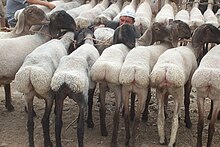Tail fat


Tail fat is the fat of some breeds of sheep, especially of fat-tailed sheep. It is fat accumulated in baggy deposits in the hind parts of a sheep on both sides of its tail and on the first 3–5 vertebrae of the tail. The weight of this part of a sheep's anatomy (for example, the sheep of the Hissar breed) may be up to 60 kg (130 lb).[1] These hind parts are used to accumulate fat for subsequent use during dry seasons, similar to a camel's humps.[2][3]
It is known under the name kurdyuk in
Tail fat is known in Arabic as لية, (leeyeh, leyyah, or layeh), zaaka in Algeria, kuyruk yağı 'tail fat' in Turkish, and دنبه [donbe or dombe] in Iran,[2] אַלְיָה (Alya) in Hebrew, words which may be found in ancient texts as well as in local food culture and in sheep breeds' names.
The
References
- ^ "Гиссарские бараны и овцы". Узбекистан: гид по стране (in Russian). Retrieved 2023-05-24.
- ^ a b c d Tilsley-Benham, Jill (1986). "Sheep with Two Tails: Sheep's Tail-Fat as Cooking Medium in the Middle East". Oxford Symposium on Food and Cookery. The Cooking Medium. p. 48.
- ^ a b . Brockhaus and Efron Encyclopedic Dictionary (in Russian). 1906.
- ^ a b Food Culture in Russia and Central Asia by Glenn Randall Mack, Asele Surina, p. 111, at Google Books
- ISBN 90-04-13153-1.
- ^ "Kuyruk".
